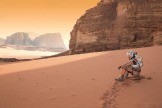I didn’t set out to develop a collection of meteorites. It just happened. I didn’t search out websites about collecting meteorites either. I jumped in and let my interest develop and guide me. In this installment of Meteoritical Me I’m going to describe some of my experiences in developing a collection, what references and tools I found useful, the kind of collection I developed and other thoughts I had on the subject. I will describe the hobby of meteorite collecting based on my own experience and perspective. I hope others might find it useful if they start into the hobby. There are a couple things I won’t be talking about. I won’t be talking about how to make money by selling meteorites. I haven’t tried it, so I’m no help there. I won’t be talking about combing the desert with a metal detector to find meteorites because I’ve never had the opportunity to do that either. If, someday, I get a chance to try it, I’ll write another blog about the experience. For now, I’ll let someone else have that fun.
If you read the first post in this series you’ll know that I began collecting a few specimens before giving any real thought to becoming a collector. It wasn’t until I learned about Pallasites that the interest really took off. When my curiosity had truly been grabbed, I jumped right in with both feet. I read Wikipedia (always the quick go-to about anything), pulled up scientific articles on the web and bought a few books. I began reading all I could about the different types and the theories about their formation. I learned about their rarity and mineralogical content. I began to form opinions about which types were more fascinating to me than others. It wasn’t until then, after I had built a foundation in general knowledge of meteorites, that I gave thought to how I would focus my collection. I imagine everyone’s path into the hobby is unique in some way. Mine may have been a little backwards in that I went solo long before getting connected to the community, but none-the-less it wasn’t a bad path.
References
There a lot of books out there about meteorites. On Amazon I found old books, new books and all in between. I decided I wanted newer books, and those published since 2000 should do. No sense in learning outdated, or wrong theories. I read reviews on Amazon and ultimately settled on two books. The first was Rocks from Space by O. Richard Norton. The second was Meteorites, by C. Smith, S. Russell & G. Benedix. Rocks from Space was my favorite go-to book. While I hope to go back and read the entire book, I was too impatient and cut right to “Part II: What is a Meteorite?” and read it several times. This section covered all the various types of meteorites, how they were named and theories about where they came from or how they formed. The formation theories were mind boggling!
My second source of information was published scientific papers. I found more of them than I had time to read. One of the best was Systematics and Evaluation of Meteorite Classification written by Michael Weisberg, Timothy McCoy and Alexander Krot. Here I not only expanded my understanding of the some of the meteorite types, but also more about of the fascinating mysteries we have yet to solve. It was during all this reading I became primarily fascinated with the Carbonaceous Chondrites and the formation of CAIs (See Meteoritical Me Part 2: Favorites)
Another awesome source of info about various meteorites is the Meteoritical Bulletin Database at http://www.lpi.usra.edu/meteor/about.php . The description from this website says it all: “The primary function of this database is to provide authoritative information about meteorite names….In addition, this database is a clearinghouse for basic information about each meteorite, including the classification, place and year of discovery, whether if it was observed to fall, references to catalogues in which the meteorite is described, and known synonyms that may be encountered in the literature.” Whenever I want to learn more about a named meteorite I start with this website. It serves as a jumping off point for other articles that may have more information. Also, I often check this site before I buy a named meteorite to confirm some of the information the seller may be claiming about its classification or discovery.
Terminology
When I started buying meteorite samples I ran into a whole new language. As a result, I couldn’t ask an intelligent question about them if my life depended on it. Since I had shortcut my learning to just meteorite types, I had to pick up this terminology later than I probably should have. I’ll give ‘Bill’s” definition of some that I learned. Here are the key terms to know.
NWA
Arid or desert lands are great locations for searching for and finding meteorites, so I hear. The ground is nearly barren and devoid of pesky grass or trees or water that meteorites can hide in. Parts of Africa are perfect for meteorite hunting. NWA is short for NorthWest Africa. The acronym is used in the naming of numerous meteorites found in that region. The name will use the format NWA-####, where #### will be an assigned sequential number. Many of my meteorites are NWA finds. Figure 1 is an example description of an NWA meteorite in the Meteoritical Bulletin.
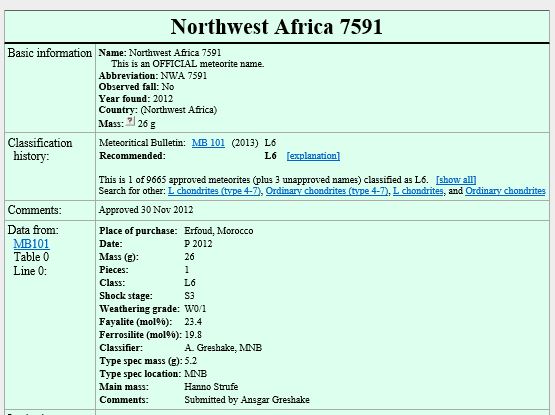
Figure 1. – Example entry from the Meteoritical Bulletin Database . Notice the NWA acronym, and description of being an observed fall or not, as well mass and shock.
Shock
You can imagine that in-space impacts with other meteoroids or the shock of entry and impact may fracture the meteorite. This fracture can be evident in physical fracture lines emanating through the entire sample. Shock can also be seen in individual chondrules as shatter lines. Shock can also result in metamorphism due to the sudden heating and high pressure. It takes expert study of the specimen to determine the level of shock it has experienced. Shock is measured on a subjective scale of S1 to S6, with S6 being the highest degree of shock experienced. For example, the meteorite description in Figure 1 has a shock state of S3.
Finds and Falls
Simply put, a Fall is a meteorite whose entry into the atmosphere was observed. These are usually pieces that were hunted for and found immediately after the streak or fireball in the sky was witnessed. A Find refers to all other discovered meteorites.
Crust
During reentry the outer surface of a meteoroid is heated to incredibly high temperatures. As a result its surface will likely become partially or fully melted. The melted surface will solidify at or near impact and becomes a slick, smooth or glassy surface. The partially melted and solidified outer layer of the meteorite is called the Crust. Figure 2 is an example of a meteorite find having a fusion melted crust.
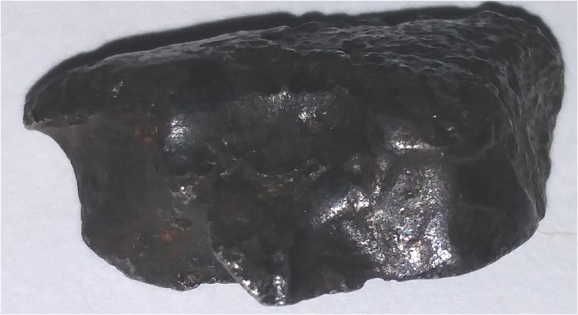
Figure 2. – 4.06g whole Piece of Sikhote-Alin Iron Octahedryte IIAB with a nice fusion melted crust.
End Cut, Slice and Part Slice
The as found meteorite is like a freshly baked loaf of bread. Now picture the bread sliced up in pieces. Collectors of whole, uncut meteorite samples may elect to cut it into pieces for type analysis and/or sale. The End-Cuts are the heals and all other slices are…well, Slices. If you then cut the slices into pieces you get Part-Slices. Brilliant, right? With End-Cuts you only get one polished side displaying interior of the sample. On the plus side you get to see what the outside looked like which can be fascinating it its own right. With Slices and Part-Slices you get more of an interior view, but little to no sense of the outside of the meteorite. Figure 3 shows some examples from my collections Figure 3 shows some examples from my collection.
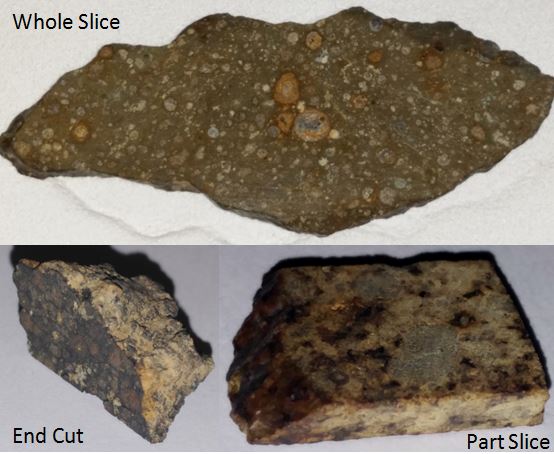
Figure 3. – Slices: Whole Slice of CV3, End Cut of CV3 NWA 8289 and Part Slice of an Anonymous ordinary chondrite. The Matrix is in the Whole Slice and End Cut is the dark material in which the chondrules, CAIs, etc are embedded. the Matrix in the Part Slides is the light brown material.
Matrix
In this context the Matrix is not a computer program but the interior rocky parts of a meteorite that surrounds the inclusions like flecks of nickel or iron, chondrules, CAIs and AOAs. The matrix of meteorites come in is a variety of colors based on it’s mineralogical content. From my point-of-view the matrix is the most underappreciated part of meteorites. Figure 3 shows three examples of the matrix of meteorites.
Micro
Most samples you’ll encounter will be described in terms of it’s mass in grams. However, if the sample is very small, maybe the size of a grain of rice or smaller, it may simply be labeled as a “Micro”. The name is short for “microgram”, meaning a weight on the order of one-thousandth of a gram. Micros aren’t often thrilling to look at unless you have a good loop or microscope. However, Micros do often provide the only affordable option for owning a sample of very rare meteorite types like Martian or Lunar finds. My Lunar and Martian samples are micros. Figure 4 is an example of a micro sample of Murchison .
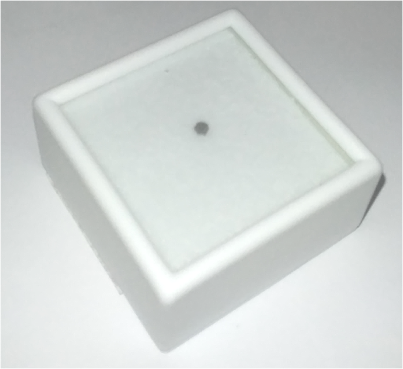
Figure 4. – Example of a Micro in a case (Murchison CM2 Carbonaceous Chondrite)
Tools and equipment
From a minimalist perspective you really don’t need any tools or equipment to sustain a meteorite collection. However, the tools and equipment I’m going to describe helped me and they’ll also help you in the long run to get more out of your collection and help you take better care of it.
Magnifying Equipment
In order to better enjoy the intricacies of the interior of the samples you’ll need a good magnifying glass. If you can get one with built in LED lighting you’re really in business. Even better, a magnifying loop with built in LEDs will provide better portability and higher magnification. Make sure the lens is glass instead of plastic. Plastic lenses scratch too ease. I have a magnifying loop with a built-in LED that I use very frequently. Figure 5 shows the magnifying lens and loop that I use.
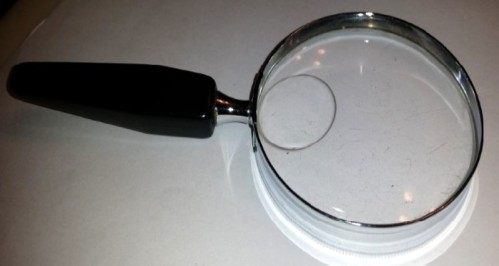
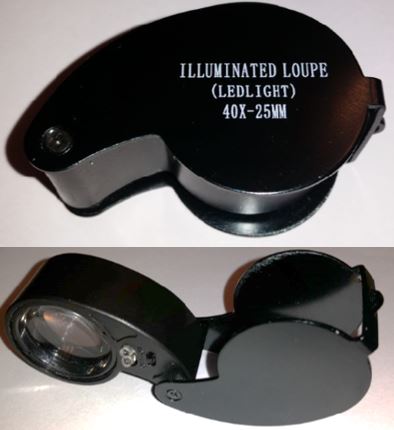
Figure 5. – Magnifying Lenses and Loops with LEDs.
Some parts of meteorites are too small to see well with a handheld lens. To really get a good look at them, a digital microscope is very useful. A digital microscope is a microscope with a built-in digital camera. When connected to your computer you see on your computer screen what the microscope sees. When you like the view simply click a button and snap a picture which is automatically saved to your hard drive. With this device you can obtain awesome pictures of the very small features hidden in the matrix of the meteorite. Believe it or not a decent digital scope is not all that expensive. Amazon has them in the $60 range, which is about how much I paid for mine. Figure 6 is a picture of it.
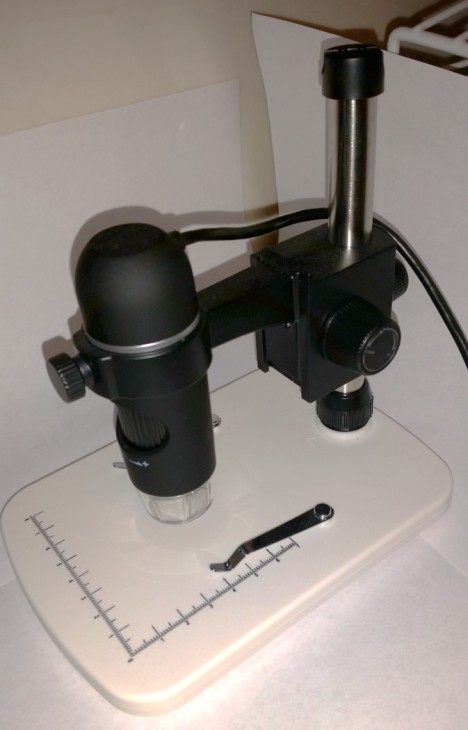
Figure 6. – Digital Microscope
Tweezers
For very small samples and micros you’ll want a pair of tweezers. I have a couple pairs that I use. Be gentle with them, however, as squeezing too hard may cause the sample to break or crush. Figure 7 shows the tweezers I use.
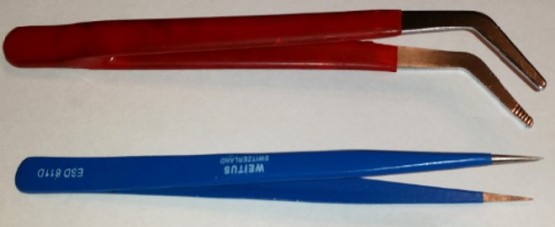
Figure 7. – Tweezers
Cases
You need cases to store your samples in. I’ve found those in Figure 8 to be most common. Basically you need a case that fits your specimens, keeps them from rattling around, has a tight fitting lid and provides visibility. Personally I’ve had some difficulty with the circular gem cases, sometimes called jem-jars, on the left. The lids for those never seem to close well. I really like the square cases that come in two sizes 1” and 1.5”. These cases have tight fitting, snap on lid with a piece of glass instead of plastic. The foam block has a black-felt side and a white-felt side. Based on the colors of your sample you may want to show off, you can choose a black or white background by simple flipping the foam block around.
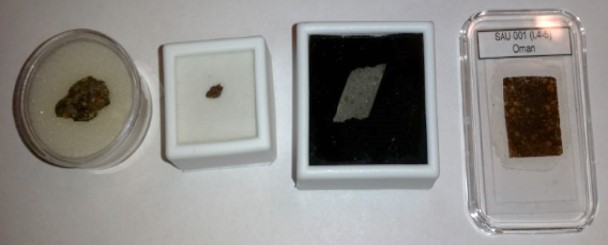
Figure 8. – Sample Cases
Weight Scale
Meteorite samples are often described by their mass in grams. If you’re like me you don’t speak that language very often. Seriously, do you have a good feel for 5 grams versus 10 grams? Having a scale can really help. In addition to measuring your samples and getting better feel of the different masses, you can also verify the mass of the samples you buy just in case someone is trying to cheat you. To be really helpful the scale you buy should give deliver measurements in increments of 0.01 g. Being pocket sized also helps so you can take it to mineral shows. I got mine from Amazon. It is made by American Weigh and only cost about $10. Shown in Figure 9, it has a backlit display and flip up cover to protect the scale. It has served me well enough for intermittent use and gives measurements well enough in agreement with the specs provided with my samples.
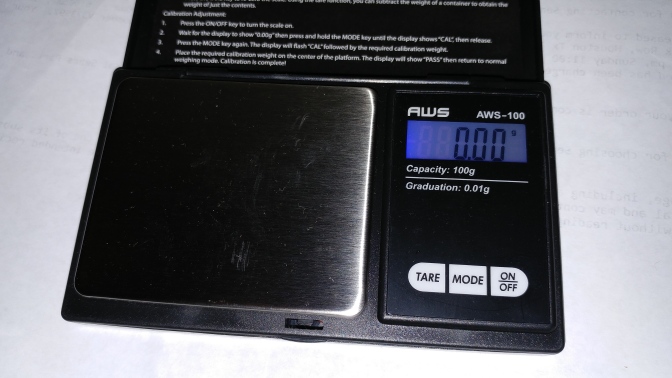
Figure 9. – Scale
Types of Collections
If you’re like me you’ll find yourself in awe about most any meteorites. You may also be so surprised at the inexpensive prices of many so you’ll buy just about any type. Eventually, however you’ll want to consider a focus to your collection. You might find yourself latching on to a particular type and focus your collection around that type. For example you may find yourself obsessed with etched iron meteorites or with certain types of chondrites. Either path you take you’ll find that having a focus will give you organization and sense of accomplishment with your collection.
I gravitated towards a Type collection. I’m attempting to collect one specimen of each meteorite type. If you take this route I have a few points of advice. First, determine a list of the types you’ll try to collect. Each book on meteorites will list the various types. Find a decently detailed list, and from it create list that will be the guide for your collection. You’ll want to take into account rarity and expense in making this list. For example, if you want to collect a specimen of Acapulcoite, you’ll have to be willing to pay quite a bit for it or wait a long time before finding a good deal. You’ll also need to decide if you want to be specific to weathering and shock in your collection. Do you want to collect samples of each particular weathering grade or is just one sample of that type, regardless of weathering or shock, good enough? Second, decide the minimum size specimens you’ll consider for your collection. Are you OK with micros or will you set a minimum sample size like 1 gram, for example? Again, remember that cost will be a factor, especially for the rare meteorite types. Third, maintain a spreadsheet or handwritten list of your inventory as you collect them. This list will help you focus on the specimens you are missing and pass on the types you already own.
Community (Organizations)
I eventually got bored of talking to myself about meteorites and wanted to talk to other people about them. I had questions that were never answered by Wikipedia and I got tired of trying to find the answers in scientific papers. I found that you can try exchanging messages with the sellers on E-Bay, but but likely they won’t have a lot of interest in being your mentor. There are other options. Here are the ones that helped me.
The easiest way to talk meteorites with others is joining Facebook groups. Two groups I’ve joined are “Meteorites” and “Meteoritical Society”. The Meteorites group is more active. This is a good place to post a question you might have or a meteorite sample you want to show off. Here is some advice before you start posting to the group. First, if you post a picture of a meteorite please include some information about it. Let people know the find information, meteorite type if you know it, in addition to the mass and maybe a ruler to give an idea of size. It would also be helpful to give some words as to why you are posting a picture of it, like a particularly interesting way you came to owning it, or why you think it is particularly interesting. Second, if you post a question, I highly recommend you do some research on your own first to attempt to find an answer before asking the larger audience. If you post a picture of a rock and say nothing but “What kind of meteorite is this?”, you are likely to not only get a good answer, but maybe some rude ones too. People will be more likely to consider you a serious collector if you back that question up with notes from your own research such as observations of apparently conflicting characteristics or references you checked that proved inconclusive.
From Facebook, and maybe from some sellers, you may hear of the IMCA and the Meteoritical Society. The International Meteorite Collectors Association, IMCA, is an excellent group who take collecting seriously, but also enjoyable. They recognize the fun and fascination in the hobby, but also the need to be diligent and careful in ensuring your meteorites are really meteorites. Their website is www.IMCA.cc . To join you’ll need two references from current members and then complete an application. This might seem excessive at first, but really quite reasonable in my opinion. Upon joining you’ll be given a member number and logo. The logo image bearing your member number can be used as proof of your legitimacy as a serious and truthful collector. I am IMCA member #7591. The members of IMCA have a family feel and are great mentors in helping others grow in the field.
Finally, there is the Meteoritical Society, from which I grabbed the term “meteortical” for the title of this series of blog posts. The Meteoritical Society is the international society for meteoritics and planetary science. From their website: “The Meteoritical Society is a non-profit scholarly organization founded in 1933 to promote research and education in planetary science with emphasis on studies of meteorites and other extraterrestrial materials, including samples from space missions, that further our understanding of the origin and history of the solar system.” They are the owners of the Meteoritical Bulletin Database and publishers of the Meteoritics and Planetary Science journal. MAPS is a peer-reviewed journal in publication since 1953. It is an awesome source of the latest research in the field.
Summary
I imagine everyone enters the meteorite collecting hobby in different ways and for different reasons. I hope some of what I have learned will be helpful to others. I would say that a theme for this post is that if you find yourself fascinated with meteorites, let your imagination and wonderment be your guide, above any other drivers. Be careful of buying fakes and arm yourself with a basic understanding of the types, the terms and the tools that might help you. There are groups of people who can help when you have questions. Good luck in your adventure in the hobby!
